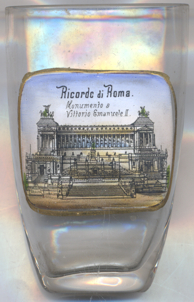

|
| ITALIA | ITALY |
| regione: Lazio | Latium |
| provincia: Roma |
 Rome (in Italian: Roma) is the capital of Italy and of its Latium region.
It is situated at an elevation of 14 m on the Tiber and Aniene rivers, near the Mediterranean Sea.
The Vatican City, a sovereign enclave within Rome, is the seat of the Roman Catholic Church
and the home of the Pope. Rome is the largest city in Italy and it also is the largest among European capital cities,
with an area of 1,290 square kilometers. Within the city limits, the population is about 2,550,000 (2004);
almost 3.5 million live in the general area of Rome as represented by the province of Rome.
Rome (in Italian: Roma) is the capital of Italy and of its Latium region.
It is situated at an elevation of 14 m on the Tiber and Aniene rivers, near the Mediterranean Sea.
The Vatican City, a sovereign enclave within Rome, is the seat of the Roman Catholic Church
and the home of the Pope. Rome is the largest city in Italy and it also is the largest among European capital cities,
with an area of 1,290 square kilometers. Within the city limits, the population is about 2,550,000 (2004);
almost 3.5 million live in the general area of Rome as represented by the province of Rome.
In mythology, Rome was founded by Romulus, who, with his brother Remus, was brought up by a wolf. He killed his brother and became the first king of the city that took his name. In historical times, the civilization of ancient Rome originated in the 8th or 9th century BC, when northern tribes migrated to the Italian peninsula to settle around the River Tiber. For almost a thousand years, Rome was the most important city in the Western world and the largest city in the world, as the capital of the expansive Roman Empire. With the rise of Christianity, Rome became the center of the Roman Catholic Church and the home of the Popes. The slow decline of the Roman Empire heralded the beginning of the Middle Ages, but the city regained prominence as the political capital of Europe for several hundred years leading up to the Renaissance. Rome remains influential today, as the capital of Italy and as a major world class metropolis.
The historic centre of Rome was listed as a UNESCO World Heritage site in 1980 (see also list of other UNESCO heritage sites).
The  Forum Romanum [left] was the central area around which ancient Rome
developed, in which commerce, business, prostitution, cult and the administration of justice took place.
A processional way, the Via Sacra, crosses it linking it with the Colosseum. By the end of the Empire, it lost its everyday
use remaining as a sacred place. The now-ruined
Forum Romanum [left] was the central area around which ancient Rome
developed, in which commerce, business, prostitution, cult and the administration of justice took place.
A processional way, the Via Sacra, crosses it linking it with the Colosseum. By the end of the Empire, it lost its everyday
use remaining as a sacred place. The now-ruined
 Temple
Temple

The  Altare della Patria [left], also known as the
Monumento Nazionale a Vittorio Emanuele II, was built in honour of King Victor Emmanuel II, the first
king of a unified Italy. It occupies a site between the Piazza Venezia and the Capitoline Hill.
The eclectic structure was designed by Giuseppe Sacconi in 1885. It was inaugurated in 1911 and completed in 1925.
The base of the structure houses the museum of Italian Unification.
The monument, the largest in Rome, was controversial since its construction destroyed a large area of the Capitoline Hill
with a Medieval neighbourhood for its sake. Popular, and in the meantime even loving, nicknames for the monument are
‘Typewriter’ or ‘Wedding cake’.
The monument also holds the Tomb of the Unknown Soldier with an eternal flame, built under the statue of goddess Roma
after World War I.
In 2007, a panoramic lift was added to the structure, allowing visitors to ride up to the roof for 360 degree views
of Rome.
Altare della Patria [left], also known as the
Monumento Nazionale a Vittorio Emanuele II, was built in honour of King Victor Emmanuel II, the first
king of a unified Italy. It occupies a site between the Piazza Venezia and the Capitoline Hill.
The eclectic structure was designed by Giuseppe Sacconi in 1885. It was inaugurated in 1911 and completed in 1925.
The base of the structure houses the museum of Italian Unification.
The monument, the largest in Rome, was controversial since its construction destroyed a large area of the Capitoline Hill
with a Medieval neighbourhood for its sake. Popular, and in the meantime even loving, nicknames for the monument are
‘Typewriter’ or ‘Wedding cake’.
The monument also holds the Tomb of the Unknown Soldier with an eternal flame, built under the statue of goddess Roma
after World War I.
In 2007, a panoramic lift was added to the structure, allowing visitors to ride up to the roof for 360 degree views
of Rome.
[http://en.wikipedia.org/wiki/Rome,
http://en.wikipedia.org/wiki/Temple_of_Saturn,
https://en.wikipedia.org/wiki/Altare_della_Patrian]
![[scale]](lineal.jpg)